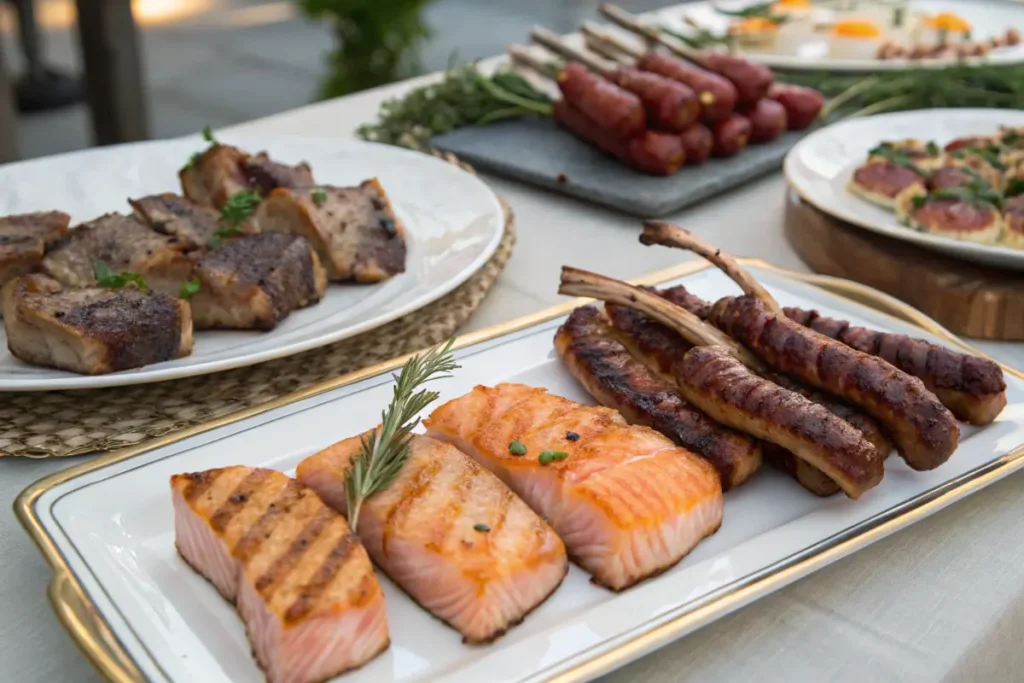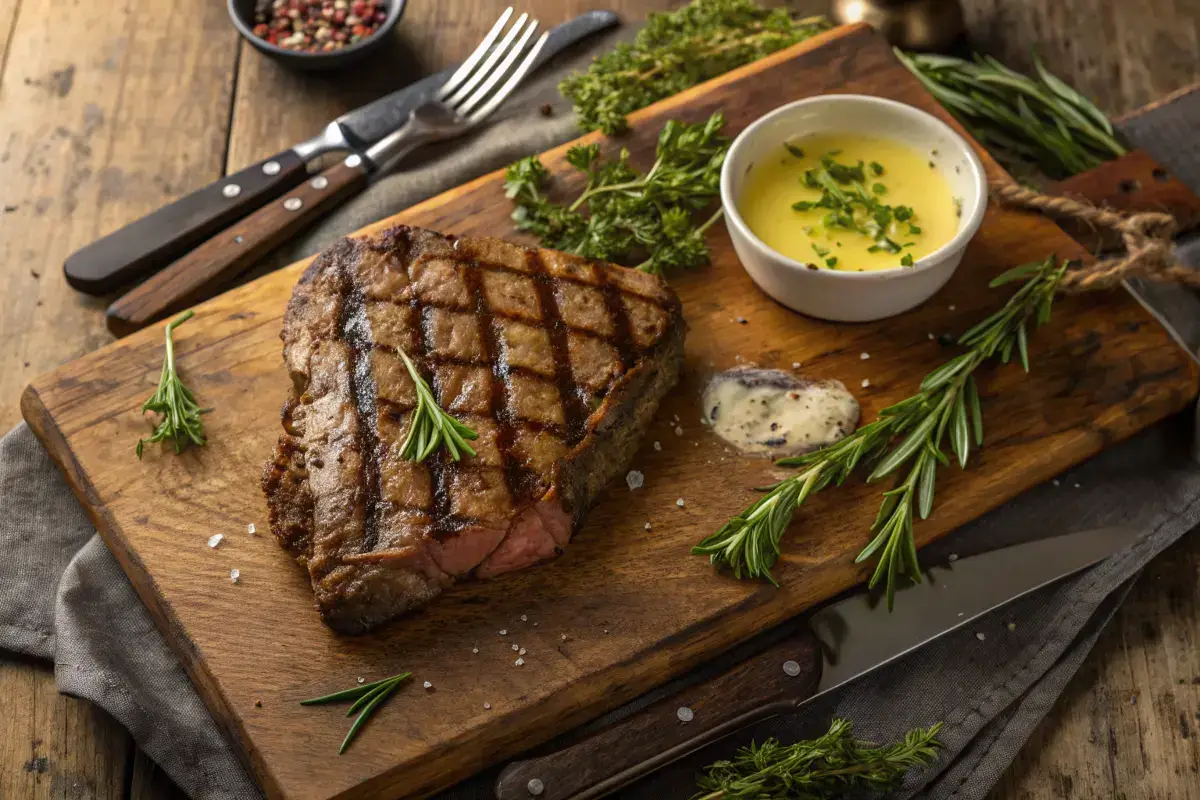The carnivore diet meal plan is more than just a trendy eating style; it’s a way to simplify your nutrition while embracing the benefits of animal-based foods. This guide is here to help you dive into the world of meat-heavy meals. We’ll explore the fundamentals of the carnivore diet, outline a detailed food list, and guide you through building a meal plan that fits your lifestyle and goals. With easy-to-follow recipes, expert insights, and tips for long-term success, you’ll find all you need to thrive on this unique diet.
So, whether you’re curious about how this diet works or ready to take the plunge, read on for the ultimate resource on going carnivore.
Understanding the Basics of the Carnivore Diet
What is the Carnivore Diet?
The carnivore diet is a high-fat, zero-carb eating plan that focuses exclusively on animal-based foods. The core philosophy is simple: eliminate plants, grains, and processed foods to embrace a diet rooted in nutrient-dense animal products. Think steak, eggs, fish, and even organ meats.
Unlike keto or paleo diets, which allow some vegetables and low-carb options, the carnivore diet takes it a step further by cutting out plant-based foods entirely. Advocates claim this approach can simplify meal planning, stabilize blood sugar levels, and improve digestion.
How the Carnivore Diet Differs from Keto and Paleo Diets
While keto emphasizes high fat with some carbs and paleo prioritizes whole, unprocessed foods (including fruits and vegetables), the carnivore diet meal plan eliminates all plant-based foods. This makes it a more restrictive, all-meat approach. Surprisingly, it’s also less complicated—no need to count macros or track carbs, as the focus is solely on animal products.
Why Choose the Carnivore Diet? Benefits and Purpose
For many, the carnivore diet is about returning to a primal way of eating. Some reported benefits include:
- Improved mental clarity and focus.
- Enhanced energy levels.
- Weight loss due to the zero-carb, high-protein nature of the diet.
- Relief from chronic conditions, such as inflammation, autoimmune issues, and bloating.
Moreover, animal-based foods like beef, liver, and eggs are nutrient powerhouses, loaded with essential vitamins like B12, iron, and zinc. If you’re tired of complicated eating plans or battling food sensitivities, a carnivore diet meal plan could be your answer.
The Essential Food List for a Carnivore Diet

Core Foods in a Carnivore Diet Meal Plan: Meat, Fish, and Animal Products
At the heart of any carnivore diet meal plan are high-quality animal-based foods. Prioritize nutrient-rich options like:
- Beef: Steaks, ground beef, and roasts.
- Fish: Salmon, mackerel, and sardines, which are rich in omega-3 fatty acids.
- Eggs: A versatile source of protein and choline.
- Pork: Think bacon, chops, and pork belly.
- Poultry: Chicken thighs, turkey, and duck.
Focusing on these foods ensures your body gets the protein and essential fats needed to function optimally.
Optional Items: Dairy and Organ Meats for Added Nutrition
To elevate your carnivore diet meal plan, include optional yet beneficial items like:
- Organ Meats: Liver, heart, and kidney are packed with vitamins A, B, and iron.
- Dairy: If tolerated, incorporate cheese, cream, and butter for variety and extra fat.
- Bone Broth: Perfect for added collagen and hydration.
While these aren’t mandatory, they can add depth and balance to your diet.
What to Avoid: Non-Carnivore Foods and Common Mistakes
Certain items should be strictly avoided:
- Plant-Based Foods: Vegetables, fruits, and grains are off-limits.
- Processed Foods: Avoid sausages and cured meats loaded with sugar or additives.
Skipping these ensures you stay true to the zero-carb, high-fat foundation of this diet.
For tips on preparing high-protein meals, explore this resource.
Designing Your Carnivore Diet Meal Plan

Daily Meal Structure: What Your Plate Should Look Like
A successful carnivore diet meal plan starts with structure. Here’s a typical day:
- Breakfast: Eggs fried in butter and bacon.
- Lunch: Ribeye steak and bone marrow.
- Dinner: Grilled salmon with a side of melted ghee.
Eating 2–3 meals daily with no snacks is common, as high-fat meals keep you full longer.
Sample Carnivore Diet Meal Plan for Beginners
Here’s a simple 3-day example:
Day 1
- Breakfast: Scrambled eggs and sausage.
- Lunch: Grilled chicken thighs.
- Dinner: Pork chops with a side of bone broth.
Day 2
- Breakfast: Hard-boiled eggs and cheese.
- Lunch: Ground beef patties.
- Dinner: Salmon cooked in butter.
3 Day
- Breakfast: Steak and eggs.
- Lunch: Lamb ribs.
- Dinner: Beef liver sautéed with ghee.
How to Customize Your Plan for Fitness Goals or Health Needs
Tailor your carnivore diet meal plan based on your activity level and health goals:
- For Athletes: Increase your protein intake by adding more steaks or fish.
- For Weight Loss: Focus on lean cuts like chicken and turkey while limiting dairy.
- For Healing Gut Issues: Stick to easily digestible foods like bone broth and tender meats.
Remember, flexibility within the diet’s guidelines helps you stay consistent and achieve your goals.
Recipes to Keep Your Carnivore Diet Exciting
Breakfast Recipes: Simple and Protein-Rich Ideas
Starting your day with the right meal is key to a successful carnivore diet meal plan. These breakfast ideas are both easy to prepare and delicious:
- Classic Steak and Eggs: Sear a ribeye in butter and serve with fried eggs for a high-energy start.
- Carnivore Omelet: Whip up eggs with bits of bacon and cheese for added flavor.
- Bacon-Wrapped Sausage Links: Wrap sausages in bacon, bake until crispy, and pair with coffee.
If you enjoy experimenting with protein-packed breakfasts, you might want to explore more options like high-protein breakfast recipes.
Lunch and Dinner Ideas for the Carnivore Diet
Your carnivore diet meal plan doesn’t have to be repetitive. These lunch and dinner recipes will help keep things interesting:
- Grilled Lamb Chops: Season generously with salt and pepper, then grill to perfection.
- Butter-Basted Salmon: Pan-sear salmon in butter, ensuring a crispy outside and tender center.
- Slow-Cooked Beef Short Ribs: A melt-in-your-mouth meal perfect for dinner after a long day.
For hearty and filling dinner options, check out high-protein dinner ideas.
Snacks and Easy-to-Prepare Meals
When you’re short on time, these snack ideas come to the rescue:
- Cheese and Salami Rolls: Simple and portable, perfect for busy days.
- Bone Broth: Warm and nourishing, ideal for sipping between meals.
- Pork Belly Bites: Roast chunks of pork belly in the oven for crispy goodness.
For more snack ideas, feel free to browse other recipes on Top Fitness Meals to get creative.
The Science Behind the Carnivore Diet
Nutritional Insights: Macronutrient Breakdown
The carnivore diet meal plan focuses on two primary macronutrients: protein and fat. While carbohydrates are excluded, the diet emphasizes foods rich in:
- Protein: Builds and repairs tissues while keeping you full.
- Healthy Fats: Serve as the main energy source, aiding in brain function and hormone production.
Foods like beef, salmon, and eggs provide a balanced combination of these nutrients, ensuring you meet your body’s needs.
How the Carnivore Diet Impacts Your Body
When you follow a carnivore diet meal plan, your body undergoes significant changes:
- Ketosis: Without carbs, your body burns fat for fuel, aiding in weight loss.
- Reduced Inflammation: Many people report less bloating and joint pain.
- Steady Energy Levels: Fat metabolism provides long-lasting energy without sugar crashes.
However, it’s important to monitor your health, especially in the early stages when your body adjusts.
Research on Long-Term Health Benefits and Risks
While the carnivore diet meal plan is praised for its simplicity, research is still evolving. Here’s what we know so far:
- Potential Benefits: Improved mental clarity, better digestion, and weight loss.
- Possible Risks: Nutrient deficiencies if you don’t consume organ meats or diversify your protein sources.
If you’re looking to dive deeper into nutrition and meal planning, consider checking out resources like 30-day carnivore diet meal plans to build a more structured approach.
Common Challenges and Solutions in a Carnivore Diet
Adapting to the Transition Period: What to Expect
Starting a carnivore diet meal plan can be a big change for your body, especially if you’re used to eating carbs. During the first week, many people experience symptoms often called the “keto flu,” which include fatigue, headaches, and cravings. These occur because your body is shifting from burning carbs to burning fat for energy.
To ease the transition, stay hydrated and increase your intake of electrolytes like salt, potassium, and magnesium. Bone broth is an excellent addition during this time, as it helps replenish lost nutrients.
How to Address Common Side Effects (e.g., Fatigue, Cravings)
Beyond the initial adjustment period, some individuals encounter challenges like:
- Constipation: This is common as your body adapts to a low-fiber diet. Incorporate more fatty cuts of meat or consider adding bone marrow for natural lubrication.
- Cravings for Carbs: Combat this by eating high-fat meals, which help you stay full longer.
It’s also vital to listen to your body. If you feel overly tired or notice persistent issues, tweak your carnivore diet meal plan by adding organ meats or increasing fat intake.
Tips for Long-Term Success on the Carnivore Diet
Succeeding on the carnivore diet meal plan requires consistency and preparation. Plan meals ahead of time and always have quick options like pre-cooked steaks or hard-boiled eggs on hand. Having a support group or online community can also keep you motivated.
FAQs About the Carnivore Diet
What Do I Drink on the Carnivore Diet?
Drinks are just as important as food in a carnivore diet meal plan. Stick to water, coffee, and tea (preferably unsweetened). Adding a pinch of salt to your water can also help maintain electrolyte balance. Avoid sugary drinks, fruit juices, and plant-based milk.
Can You Eat Dairy on the Carnivore Diet?
Dairy is generally optional. Some people include cheese, cream, and butter in their carnivore diet meal plan for variety. However, if you’re sensitive to dairy, it’s best to avoid it to prevent bloating or inflammation.
Is the Carnivore Diet Safe for Everyone?
While many people thrive on a carnivore diet meal plan, it’s not for everyone. Those with specific health conditions like kidney disease or certain heart issues should consult a healthcare provider before starting. Pregnant or breastfeeding women should also seek medical advice to ensure they’re meeting nutritional needs.
For more tips and support, explore resources or connect with experienced carnivore dieters who can share practical advice for sticking to this plan.
Long-Term Benefits of the Carnivore Diet Meal Plan
Physical Benefits of Following a Carnivore Diet
A well-structured carnivore diet meal plan offers many physical benefits, especially for those seeking to improve their health and energy levels. By eliminating processed foods and carbs, you may experience:
- Weight Loss: With fewer carbs and more protein, the body burns fat efficiently, leading to weight loss.
- Improved Digestion: Many people report relief from bloating, gas, and other digestive issues.
- Higher Energy Levels: Relying on fat for fuel provides sustained energy without the sugar crashes common in carb-heavy diets.
Additionally, some individuals notice better skin health and fewer inflammatory conditions, making this diet attractive for those with autoimmune challenges.
Mental and Emotional Benefits
The benefits of a carnivore diet meal plan aren’t limited to physical health. Many people experience:
- Better Focus and Mental Clarity: A steady supply of healthy fats and proteins supports brain function.
- Stable Moods: With no sugar spikes and crashes, emotional stability improves over time.
- Reduced Cravings: High-fat meals keep you full and satisfied, making it easier to resist temptations.
While everyone’s results will vary, sticking to the diet long-term can unlock these advantages, provided you stay consistent and adjust as needed.
Crafting the Perfect Carnivore Diet Meal Plan for You
Tailoring the Diet to Your Lifestyle
A carnivore diet meal plan is not one-size-fits-all. It’s essential to personalize it based on your needs and goals. If you’re an athlete, increase your protein intake to fuel your workouts. For those aiming to lose weight, prioritize leaner meats and limit dairy products.
Meal prepping can make this lifestyle easier. Cook your proteins in bulk—think steaks, chicken thighs, and lamb chops—so you always have something ready.
Tips for Sustaining the Plan Long-Term
Sticking with a carnivore diet meal plan can be challenging at first, but with the right mindset and tools, it gets easier. Here are some tips:
- Rotate Your Meats: Incorporating variety, such as beef, fish, and organ meats, prevents boredom and ensures balanced nutrition.
- Stay Hydrated: Drink plenty of water and supplement with electrolytes to stay energized.
- Track Your Progress: Keep a journal to monitor how you feel, track your weight, and note any changes in energy or mood.
By keeping these strategies in mind, you can create a carnivore plan that works for your goals and lifestyle.

